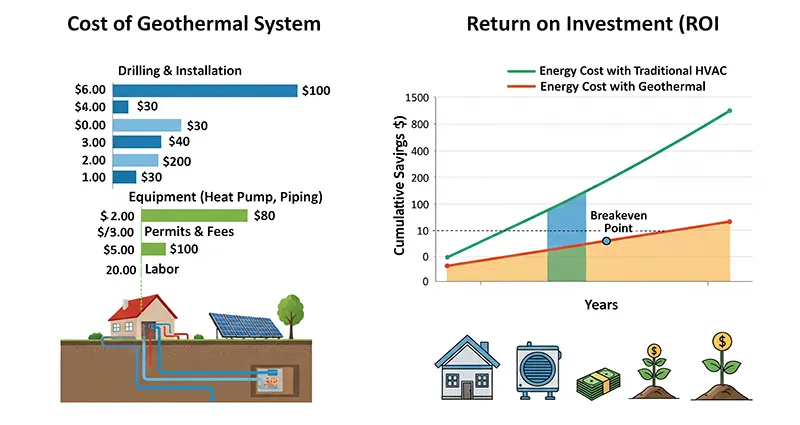As homeowners and businesses seek sustainable and energy-efficient solutions, geothermal heating and cooling systems have gained significant attention. These systems leverage the earth’s stable underground temperatures to provide efficient climate control. However, a crucial consideration before investing is understanding the cost and ROI of geothermal heating and cooling systems.
What is the Cost of Geothermal Heating and Cooling Systems?
The initial cost of installing a geothermal system tends to be higher than traditional HVAC systems. This is primarily due to the specialized equipment and the need for drilling ground loops underground.
- Installation Costs: Typically range between $30,000 and $60,000, depending on system size, location, and ground conditions.
- Equipment Costs: The geothermal heat pump itself costs between $10,000 and $20,000.
- Drilling and Ground Loop Installation: Can be $15,000 to $30,000, heavily influenced by soil type and depth.
- Maintenance Costs: Relatively low, usually $200 to $500 annually.
- Operational Costs: Geothermal systems use electricity more efficiently, leading to savings between 30% to 70% on heating and cooling energy bills compared to conventional systems.
Calculating the ROI of Geothermal Systems
Return on Investment (ROI) depends primarily on energy savings, system lifespan, and any available incentives or rebates.
- Energy Savings: With reduced heating and cooling costs, property owners typically see significant monthly reductions in utility bills.
- Incentives: Federal tax credits (often around 30% of system cost) and local rebates can substantially lower the upfront expenditure.
- Payback Period: On average, homeowners recover their investment within 5 to 12 years, depending on energy prices and available incentives.
- Property Value: Installing geothermal systems may increase a property’s market value, further enhancing the ROI.
Factors Affecting Cost and ROI
Several factors influence the cost and ROI:
- Geographic Location: Areas with higher energy costs realize faster ROI.
- Soil and Site Conditions: Hard or rocky soil can increase drilling costs.
- System Size and Usage: Larger or commercial systems have different cost dynamics and may provide faster ROI due to scale.
- Energy Prices: Rising electricity and fossil fuel prices improve the economic attractiveness.
- Maintenance and Longevity: Geothermal systems typically last 20-25 years, with ground loops lasting up to 50 years, translating to long-term ROI.
When evaluating the cost and ROI of geothermal heating and cooling systems, it’s important to consider upfront expenses alongside long-term energy savings and incentives. Despite a higher initial investment compared to conventional HVAC systems, geothermal systems offer significant operational savings, environmental benefits, and increased property value over time. Therefore, for many homeowners and businesses, geothermal systems represent a smart, cost-effective investment in sustainable climate control.












